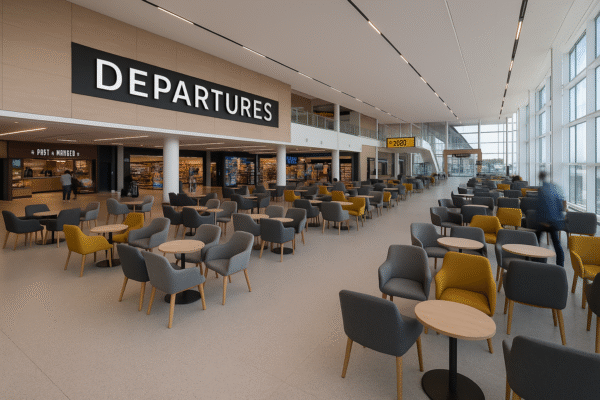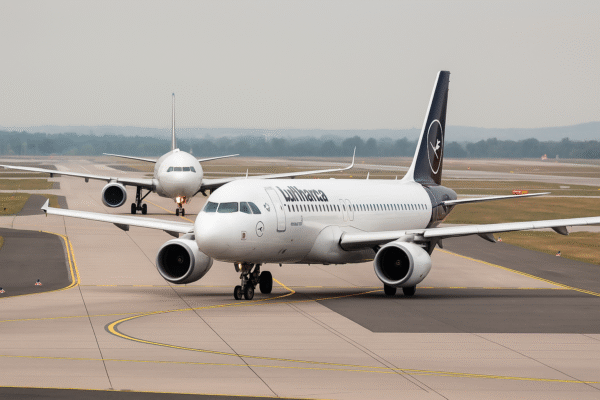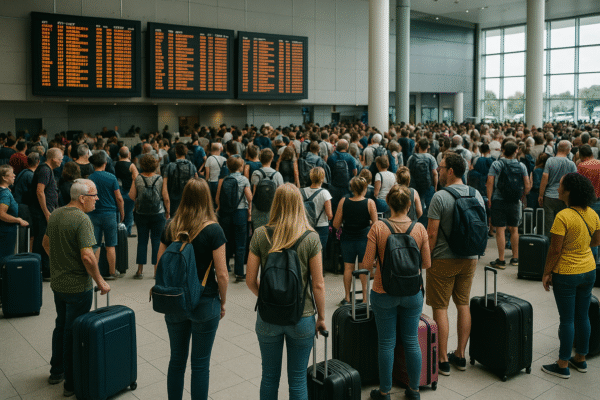UK Air Travel Thrown into Chaos as Heathrow Hit Hard by NATS System Failure
LONDON, UK – July 31, 2025 — Heathrow Airport, the UK’s busiest aviation hub and a critical global transit point, experienced severe travel disruptions today following a major technical failure at the National Air Traffic Services (NATS) control centre in Swanwick, Hampshire. The issue, which impacted air traffic control systems across the United Kingdom, led to widespread grounding of flights, resulting in delays, cancellations, and stranded passengers at multiple airports.
Technical Fault Cripples National Air Traffic Control
According to NATS, a “critical systems fault” early this morning led to the temporary suspension of all departures and significant restrictions on inbound flights to ensure airspace safety. The technical issue affected radar systems and automated flight planning tools, triggering nationwide flight delays.
While the fault was identified and resolved within hours, the damage had already been done. Heathrow bore the brunt of the impact due to its high volume of international flights, with dozens of cancellations reported. London Gatwick, Manchester, Birmingham, and Edinburgh airports also experienced delays and schedule disruptions.
Heathrow Faces Gridlock as Passengers Stranded
The scenes at Heathrow’s terminals reflected widespread chaos. Long queues formed at check-in counters and departure gates, with little clarity for passengers. Flight information displays showed wave after wave of delays. Airline staff struggled to accommodate affected travelers, with many waiting hours to rebook or receive updates.
A Heathrow spokesperson confirmed the airport was working closely with NATS and airline partners to manage capacity and rebook flights where possible. “We regret the inconvenience caused and are doing all we can to minimize disruption for passengers,” the statement read.
Some airlines, including British Airways and Virgin Atlantic, offered meal vouchers and overnight accommodations to affected passengers. However, the scale of the disruption meant many passengers remained uncertain about when they could resume their journeys.
Ripple Effect Across the UK and Beyond
The disruption’s impact extended well beyond Heathrow. At least 1,200 flights across UK airports were delayed, with hundreds cancelled, according to aviation analytics firm Cirium. International carriers en route to the UK were forced to delay departures or divert aircraft mid-flight to alternative airports.
Passengers with connecting flights to Europe, North America, Asia, and the Middle East faced additional turmoil as missed connections threw global itineraries into disarray.
Transport Secretary Louise Haigh addressed the House of Commons, stating, “This incident highlights the importance of strengthening our aviation infrastructure. While NATS responded quickly, we must prevent such failures from paralyzing the system again.”
Airlines Urge Passengers to Monitor Flights
Airlines have advised travelers to check their flight statuses directly on airline apps and websites before heading to the airport. Heathrow and other airports are also updating passengers through social media and official terminals.
Industry experts recommend that travelers opt for rebooking through airline mobile platforms or customer hotlines rather than waiting at airport counters, which are experiencing overwhelming demand.
For travelers who missed flights due to the outage, most airlines have waived rebooking fees and are offering priority seating on the next available services. Still, high passenger volumes may mean delays extending into the following day.
Aviation Industry Calls for Modernization
This incident has once again raised questions about the resilience of the UK’s air traffic control infrastructure. Despite previous investments in digital flight data systems and radar enhancements, today’s failure shows vulnerabilities remain.
The UK Civil Aviation Authority (CAA) has launched an independent review of the NATS system fault and its response. Early indicators suggest the fault was not the result of cyber interference but rather a technical system error during routine software synchronization.
With UK air traffic volume projected to rise by 20% over the next decade, industry stakeholders say systemic upgrades are urgently needed. “We need to invest in more advanced, fault-tolerant systems that can withstand increasing operational complexity,” said Paul Smith, director at the Aviation Infrastructure Network UK.
Government and Industry Response
The Department for Transport confirmed it will coordinate with NATS, the CAA, and UK airports to implement recommendations from the forthcoming review. A long-term infrastructure upgrade plan may receive accelerated funding under the government’s National Aviation Strategy.
Aviation Minister Rupert Greenwood emphasized, “Passenger confidence is key to the UK’s global travel leadership. We cannot afford to let technology setbacks erode trust in our air traffic systems.”
Conclusion: Resilience Must Be the Priority
As Heathrow and other UK airports gradually return to normal operations, today’s disruption underscores the fragility of critical aviation infrastructure. With the UK positioning itself as a leader in global travel and tourism, maintaining the integrity of its airspace operations is not just a technical matter—it’s an economic imperative.
The incident serves as a reminder that robust, fail-safe air traffic control systems are essential for the smooth functioning of the travel industry. For now, passengers are advised to stay informed, exercise patience, and plan ahead as airlines work tirelessly to clear the backlog.
For more travel news like this, keep reading Global Travel Wire





















